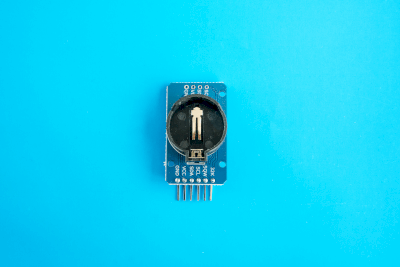What Is a Real-Time Clock?

A real-time clock is an IC device with clock functions.
Also called an RTC (real-time clock), some models have programmable time alarms and automatic leap year correction functions.
Since the clock needs to keep ticking even when the main device is turned off, it has its own power supply independent of the main device. Electronic devices that require clock functions can also operate without a real-time clock if only relative time is needed.
Uses of Real-Time Clocks
Real-time clocks are used in devices that require current time. By connecting it to a power supply or backup that is separate from the power supply on the embedded system, the clock can keep ticking even if the system power supply is turned off. Examples include personal computers, game consoles, pachinko machines, telephones, fax machines, and rice cookers.
A personal computer reads from a real-time clock to know the current time when the operating system is started. In game consoles and pachinko machines, it is used to generate events or activate effects that correspond to the real time or period. Telephones and fax machines are used to display calendars and time. Rice cookers are used for timer functions.
Principle of a Real-Time Clocks
A real-time clock consists of a quartz crystal and an oscillation circuit.
The quartz resonator is a piezoelectric element, characterized by the piezoelectric effect of regular vibrations. When the vibrations are converted into electricity and extracted from the quartz resonator, a regularly oscillating electrical signal can be obtained, and an alternating current signal with a single frequency can be obtained.
An oscillation circuit is a component or device that creates an AC signal of a desired frequency from a DC power source. The oscillation circuit can continuously generate a signal with periodicity.
The quartz crystal and the oscillation circuit make up a real-time clock that keeps accurate time. Quartz crystal units are used because they have a high Q (quality factor) and steep passband characteristics, allowing selective and accurate frequency extraction. This enables accurate timekeeping.
In addition, a real-time clock has an independent power supply with lower power consumption than the timer function of an operating system or other devices. Since it does not require much power, it can operate for a long period, even if the main unit’s power is turned off.
How to Select a Real-Time Clock
There are three factors to consider when selecting a real-time clock: time accuracy, long operation time, and size.
1. Time Accuracy
A real-time clock with high accuracy is required for devices that measure usage in cases where the rate system changes according to the time of day. Since quartz crystal oscillators fluctuate in frequency depending on temperature, a model equipped with a temperature compensation circuit is necessary.
2. Long Time Drive
If the device needs to be driven for a long period, consider a model with low power consumption, or a model that automatically switches the power supply to be supplied from the main unit when the main unit power is on.
3. Size
If the size of the device is limited, select a real-time clock with a reduced number of components or a real-time clock in a single package.
Other Information on Real-Time Clocks
1. Characteristics of Real-Time Clocks
Real-time clocks are equipped with functions necessary for calendars, such as leap years, major months, and minor months, making it easy to program date-related programs in embedded devices. Power consumption can be reduced by operating only the real-time clock and turning off the main unit when not needed.
2. Functions of the Real-Time Clock
In addition to providing basic time and calendar information, some models offer the following functions:
- Alarm
Outputs a signal at a set time. - Backup Power Switching
Switches from the internal battery to the main unit’s power supply when the main unit’s power supply is on. - Time Stamp
Stores time data when an event is detected. - Reset
Monitors the power supply of the main unit and outputs a reset signal to the CPU when a threshold value is detected.